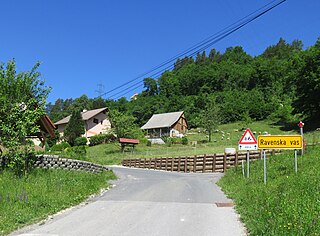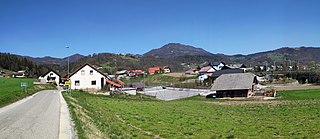
Mislinja is a settlement in northern Slovenia. It is the seat of the Municipality of Mislinja. It lies in the valley of the Mislinja River. The area traditionally belonged to Styria. In 1995 it became part of the newly formed Carinthia Statistical Region.
Dogoše is a village and a suburb of Maribor on the right bank of the Drava River in northeastern Slovenia in the City Municipality of Maribor.

Crngrob is a small village in the Municipality of Škofja Loka in the Upper Carniola region of Slovenia.

Kamniška Bistrica is a small dispersed settlement close to the source of the Kamnik Bistrica River in the Municipality of Kamnik in the Upper Carniola region of Slovenia.

Podgorje is a settlement that is a now a suburb of the town of Kamnik in the Upper Carniola region of Slovenia.

Stomaž is a village in the hills north of the Vipava Valley in the Municipality of Ajdovščina in the Littoral region of Slovenia. It is made up of several smaller hamlets: Brith, Dolenja Vas, Hrib, Ljubljanica, Griže, Črnigoji, Bratini, and Batagelji.

Dolenje pri Jelšanah is a village north of Jelšane in the Municipality of Ilirska Bistrica in the Inner Carniola region of Slovenia, next to the border with Croatia. The settlement includes the hamlets of Dolnji Kraj, Gornji Kraj, and Vrh Žloštajna.
Dolnji Zemon is a small settlement on the left bank of the Reka River south of Ilirska Bistrica in the Inner Carniola region of Slovenia. It includes the hamlet of Zemonska Vaga.
Harije is a village in the hills west of Ilirska Bistrica in the Inner Carniola region of Slovenia.

Selo pri Pancah is a small settlement in the City Municipality of Ljubljana in central Slovenia. It lies in the hills southeast of the capital Ljubljana. The area is part of the traditional region of Lower Carniola and is now included with the rest of the municipality in the Central Slovenia Statistical Region.

Ravenska Vas is a settlement immediately east and southeast of Zagorje ob Savi in central Slovenia. The area is part of the traditional region of Upper Carniola. It is now included with the rest of the municipality in the Central Sava Statistical Region.
Dobovec is a settlement in the Municipality of Trbovlje in central Slovenia. It lies in the hills above the right bank of the Sava River. The area is part of the traditional region of Lower Carniola. It is now included with the rest of the municipality in the Central Sava Statistical Region.

Podkraj is a settlement in the Municipality of Hrastnik in central Slovenia. It lies on the right bank of the Sava River. The area is part of the traditional region of Lower Carniola. It is now included with the rest of the municipality in the Central Sava Statistical Region. It includes the hamlets of Sava, Koritnik, Strušce, Kladje, Ruda, Boriče, and Hribar.
Lahomno is a settlement in the Municipality of Laško in eastern Slovenia. It lies in the valley of Lahomnica Creek, a minor left tributary of the Savinja River east of Laško. The area is part of the traditional region of Styria. It is now included with the rest of the municipality in the Savinja Statistical Region.
Lobnica is a settlement in the Municipality of Ruše in northeastern Slovenia. It lies in the Pohorje Hills south of Ruše. The area is part of the traditional region of Styria. The municipality is now included in the Drava Statistical Region.

Gornji Dolič is a village in the Municipality of Mislinja in northern Slovenia. The area is part of the traditional region of Carinthia and is now included in the Carinthia Statistical Region.

Marija Reka is a settlement in the Municipality of Prebold in east-central Slovenia. It lies in the hills south of Prebold. The area is part of the traditional region of Styria. The municipality is now included in the Savinja Statistical Region. The settlement includes the hamlets of Mala Reka, Velika Reka, and Jelenca.

Breg is a settlement on the left bank of the Sava River in the Municipality of Sevnica in central Slovenia. The area is part of the historical region of Styria. The municipality is now included in the Lower Sava Statistical Region. The settlement includes the hamlets of Gradišče, Jelše, and Zagradec.

Log is a village on the right bank of the Sava River in the Municipality of Sevnica in eastern Slovenia. The area is part of the historical region of Lower Carniola. The municipality is now included in the Lower Sava Statistical Region.
Pečje is a settlement in the Municipality of Sevnica in central Slovenia. It lies just east of Sevnica above the left bank of the Sava River The area is part of the historical region of Styria. The municipality is now included in the Lower Sava Statistical Region.























